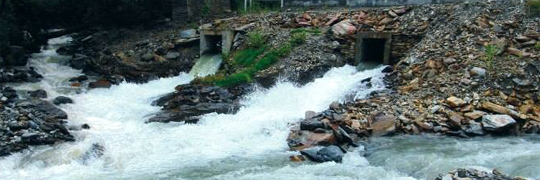The politics of inefficient irrigation technology
Call it is one of the unknown Indian ironies. Over many years, the Indian state, through its public irrigation agencies, has systematically taken over the management of surface water systems. It has
Call it is one of the unknown Indian ironies. Over many years, the Indian state, through its public irrigation agencies, has systematically taken over the management of surface water systems. It has
The botted water industry is global in nature. But it is designed to sell the same product to two completely different markets one water rich and the other water scarce. The question is whether this
How will vast regions of India, where highly unreliable rainfall makes the difference between famine and sustenance, cope with climate change? Over 85 per cent of the cultivated area in this country
The recently completed first ever research on the plant biodiversity of the Khirthar Range has found around 197 species, many with medicinal properties, which are under serious threat of extinction due to human activities, including construction, extensive chopping of trees and large shrubs for use as fuel wood, as well as ecological stress. The three-year study, funded by the Higher Education Commission (HEC), suggests immediate large-scale conservation and development of the plant biodiversity of the Khirthar Range, which, it says, has great potential for commercial exploitation for medicinal purposes that would not only reduce pressure on the wild stocks, it would also help alleviate poverty. Other recommendations include the provision of alternate sources of income and fuel to the locals and the initiation of measures to ensure minimum disturbance to the natural habitat while developing Gorakh Hill as a resort. "It's the first ever research on plant biodiversity of the entire Khirthar Range. Earlier, a baseline study was conducted in 2000, but that was only restricted to Khirthar National Park,' said Professor Dr Anjum Perveen of the University of Karachi's botany department, who conducted the research. She said that more research was needed to explore the entire plant biodiversity of the Khirthar Range that extends southwards for about 190 miles from the Mula River in east-central Balochistan to Cape Muari (Monze) west of Karachi on the Arabian Sea. "My research is a small step that needs to be strengthened by further studies. I would have loved to go to the top of the highest peak, Kutte-ji-Qabar (at about 6,878 feet above sea level) that remains covered with snow for many months, but couldn't do so without any logistical support and had to be content with the area within our reach,' she said. It was because of these limitations that eight sites were selected for research. These included Khirthar National Park, Rani Kot, Kutte-ji-Qabar, Batro Jabal, Pir Ghazi Shah and Gorakh Hill (the second highest peak of the Khirthar Range), Dureji and Tiko Baran. "A great source of limestone, gravel, salt, sand and marble, the entire Khirthar Range, that includes protected areas of Khirthar National Park, Mahal Kohistan Wildlife Sanctuary and the Sumbak Game Reserve, is covered with calcareous rocks and has a desert climate. The average temperature ranges between 44 to 48 degrees centigrade in summer and 30 to 35 degrees centigrade in winter at daytime. At night, it drops to as low as 10 to 15 degrees centigrade. The altitude varies from about 1,000 metres in the south to 2,400 metres in the north,' she responded when asked about the geographical and climatic conditions of the area. Incredible diversity The team recorded 197 plant species, distributed in 60 families, the most dominant being Poaceae, followed by Compositae, Papilionaceae and Solanaceae. Species like Neurada procumbens, Corallocarpus epigaeus, Commelina albescens, Moringa concanensis, Plantago ciliata, Plantago stocksii, Olea ferruginea, Salvadora persica, Asparagus sp., Aristolochia bracteolata, Caralluma edulis, C. tuberculata, Cometes surratense and Viola stocksii were rare species, most of which were found on Gorakh Hill. The frequently found species were Fagonia indica, Rhazya stricta, Acacia nilotica and Grewia tenax and Dodanea viscose. The two endemic species were Justicia vahlii and Ruellia sindica while Bergia suffruticosa, Seetzenia lanata and Sophora alopecuroides were the three new findings. Acacia nilotica was being extensively used as a fuel wood while Nannorophs ritchieana for making baskets and mats. Many of these plants surviving in drought conditions, she said, had medicinal properties. Some could be grown in the city and prove to be a wonderful replacement for many decorative plants that required a lot of water. For instance, Dodonaea viscosa can be used to make hedges. Among the large number of plants having medicinal properties included Plantago ciliata (ispagol), Olea ferruginea (kaho), Peganum harmala (harmal), Rhazya stricta (sewear), Tecomella undulate (rohida), Withania coagulans (paneer booti), Asparagus gharoensis (musli), Ephedra ciliata (Ephedra) and Tribulus longipetalous (gokhru). "We visited the sites from time to time during the study period and made efforts to include the representative, topographic and physiographic conditions. Though collecting specimens from inaccessible heights was an arduous task itself, the greater danger was posed by criminal elements who rule these areas and it was difficult to move independently,' she said. When asked about the most difficult and diverse spot in terms of plant biodiversity, Dr Perveen said that Gorakh Hill was the most rich. "The 5,688ft high Gorakh Hill Station is surrounded by high mountains. The most unique feature of this area is that the mercury column remains below 20 degrees centigrade even in June and July. These climatic conditions make it distinctive in vegetation, too,' she said, quickly adding that the plants had been severely damaged by construction works. "The present vegetation is already under stress due to prolonged droughts, extensive grazing, chopping and poor soil conditions. Making Gorakh Hill a resort is an excellent idea, but development shouldn't come at the cost of ecological destruction. In fact, this indigenous plant wealth can be turned into an income-generating source if the government educates locals about its significance and trains them in setting up plant nurseries,' she suggested.
<p>The time has come to develop a national consensus, define the national position and determine red lines for future negotiations, otherwise we risk endangering our future growth prospects.<br />
<p><span style="font-size:12px;"><span style="font-family: verdana,geneva,sans-serif;">With the carbon market in doldrums, emerging economies like India will have to announce bolder schemes for a low carbon

<p><span style="font-size:14px;"><strong>Rain Water Harvesting</strong></span></p> <p><span style="font-size:14px;"><strong><img alt="Rain Water Harvesting-Bangladesh" src="http://www.indiaenvironmentportal.org.in/files/country/bangladesh/rainwater_harvesting_hl.jpg" style="width: 525px; height: 297px;" /></strong></span></p> <p>Rainwater harvesting is one of the feasible options of fresh water sources in the coastal areas of Bangladesh and recently a lot of initiatives and programme were undertaken to promote and install rainwater harvesting systems both in the coastal and arsenic affected areas in Bangladesh. Moreover, every year the country is also blessed with ample rain. The average annual rainfall in Bangladesh is about 2200 mm, seventy-five percent of it occurs between May and September.</p>
<table cellpadding="0" cellspacing="0" style="border: 11px solid rgb(4, 120, 209); width: 620px;" width="550"> <tbody> <tr> <td colspan="3" height="10px"> </td> </tr> <tr>

<p>Microhydels, in which water from a river tributary or water springs is diverted into a channel and is brought down through a pressure pipe to run a generator for producing electricity, are set up in
<p>Very different global rules are needed for human wellbeing</p> <p>Averting climate change does not need emission reduction pledges, timetables and a common legal framework.</p> <p>Climate governance
Two monopolies. One private and the other public; one in gas and one in coal. Both equally disastrous for the environment. I speak here of Reliance Industries Ltd and Coal India Ltd. We know that air
<p style="line-height: 22px; font-size: 14px; margin-top: 5px; color: rgb(0, 0, 0); font-family: Arial, Helvetica, sans-serif;"><em>Car industry's efforts to dilute standards approved by PMO will significantly
<p><a href="http://www.downtoearth.org.in/author/130" style="color: rgb(0, 84, 166); text-decoration: none; position: relative; font-family: Arial, Helvetica, sans-serif; font-size: 11px; line-height:
<p><span style="font-size:14px;"><span style="font-family:arial,helvetica,sans-serif;"><strong><img alt="" src="http://www.indiaenvironmentportal.org.in/media/iep/homepage/msanwal_blog.jpg" style="width:

Mind-body medicine: in the realm of the possible but wholly inexplicable, this loose curative system has more takers every day

What determines a person"s behaviour through the vicissitudes of life: genes, environment or both? There are many who believe that genetic determinism is fascist ideology in scientific garb. There are others who hold that genetics holds the key to everlas
Studying the history of human interaction with nature can be very useful in formulating resource management policies. It can also provide a clearer insight into the causes of poverty

Why are there pesticide residues in bottled water? This isn"t an isolated query. It condenses 3-4 lines of questioning: • What kind of water do companies use as raw material?

The grossly inadequate education as imparted in our schools has to answer for our general insensitivity towards the environment

Western institutions and the United Nations are keen protagonists of natural resource accounting but it may still not be a useful policy tool for planners to promote sustainable development. Experience in the Philippines has shown that only an elaborate c